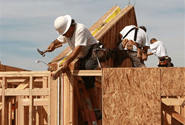Analysis

April 19, 2022
NAHB: Builder Confidence Still Moving Down in March
Written by David Schollaert
Builder confidence fell in April as strong headwinds continue to erode housing affordability and delay projects, according to the National Association of Home Builders/Wells Fargo Housing Market Index (HMI).
Homebuilder sentiment fell for the fourth straight month, as rapidly rising interest rates combined with ongoing home price increases and higher construction costs continue to take a toll on builder confidence and housing affordability
April’s HMI reading moved two-point lower to a reading of 77, keeping the index below the 80-point mark for a second consecutive month.
“Despite low existing inventory, builders report sales traffic and current sales conditions have declined to their lowest points since last summer as a sharp jump in mortgage rates and persistent supply chain disruptions continue to unsettle the housing market,” said Jerry Konter, NAHB’s chairman. “Policymakers must take proactive steps to fix supply chain issues that will reduce the cost of development, stem the rise in home prices and allow builders to increase production.”
![]()
The NAHB/Wells Fargo HMI survey gauges builder perceptions of current single-family home sales and sales expectations for the next six months as “good,” “fair” or “poor.” The survey also asks builders to rate traffic of prospective buyers as “high to very high,” “average” or “low to very low.” Scores for each component are then used to calculate a seasonally adjusted index where any number over 50 indicates that more builders view conditions as good than poor.
Two out of the three major HMI indices posted decreases in April. The index gauging current sales conditions fell two points to 85, while the component charting traffic of prospective buyers posted a six-point decline to 60. The index measuring sales expectations in the next six months increased three points to 73 following a 10-point drop in March.
“The housing market faces an inflection point as an unexpectedly quick rise in interest rates, rising home prices, and escalating material costs have significantly decreased housing affordability conditions, particularly in the crucial entry-level market,” said Robert Dietz, NAHB’s chief economist.
Looking at the three-month moving averages for regional HMI scores, the Northeast increased one point to 72, while the Midwest dropped three points to a reading of 69. The South fell two points to 82 and the West edged one point lower to 89.
By David Schollaert, David@SteelMarketUpdate.com







